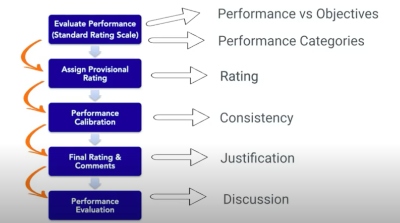How to Evaluate Employee Performance
Performance appraisals are part of an annual process that evaluates calibrates and records an assessment of an employee’s performance. The assessment reviews results, contributions and behaviours. It isn’t just about the results that are delivered; the manner in which an employee behaves in the delivery of results is a critical part of the assessment.
My training video and free Performance Management Guidebook step you through this process. Read on below video
Implementing an effective process for evaluating, managing and enhancing performance has many benefits
- It can motivate and engage employees and teams.
- Allows you to maximise employee and team delivery.
- Provides a mechanism to recognize good performance and addresses poor performance
- Supports individual growth and team development.
- Helps to retain staff.

Performance Evaluation Flowchart
This is a flowchart of the Performance Evaluation Process.
Having set objectives for the year, you now want to evaluate performance against these objectives.
Setting Employee Objectives is covered in a separate training video
Rating Scale
The evaluation process needs to be fair and equitable across the organization. To achieve this employees are assessed against a standard rating scale of performance categories.
- Each point on the scale has a clear definition and description to guide people managers on using the scale.
- The number of points on a scale and the terminology used vary by organization. Understand the system and definitions used by your company.
Based on this assessment a provisional rating is assigned by the team leader/manager.
Performance Calibration
A performance calibration exercise is carried out to ensure that people managers are consistently applying the rating scale across the organization. This exercise is led by HR and is done prior to signing off and communicating the performance ratings to employees. Following this exercise a final employee rating is assigned with justification comments.
Performance Evaluation Template
A standard performance management template is used for setting objectives and evaluating performance. Objectives are listed on the left and performance against each objective is captured on the right . My Performance Management Guidebook includes an example template.
The manager and the employee need to prepare for the performance evaluation meeting.
Employee Preparation
The employee prepares by assessing their own performance for each objective and updating the Performance Management Template providing specifics on:
- What was delivered
- How it was delivered e.g. the approach & behaviours
- The business impact (use measures and data where possible).
- The employee can also include additional deliverables not covered in the original objectives.
This gives the employee a better understanding and insight into their own performance.
Manager Preparation
- Review the employee’s self-assessment, requesting additional information as needed.
- Ask others for input to ensure a fair and balanced evaluation of employee’s performance.
- Update the performance management template.
- For annual evaluations assign a rating and write a summary paragraph representing the entire years performance, ensuring alignment of the written comments and the rating.
The next step is the annual evaluation meeting
Annual Evaluation Meeting
- The manager and employee review progress against objectives Where the manager does not agree with an employees self-assessment, evidence and examples are provided and the template is updated.
- The manager highlights good performance and how the employee’s work contributed to the annual business plan.
- The manager provides feedback to the employee on performance opportunities. Giving feedback and managing poor performance are very important skills for managers and an integral part of performance management. These are covered in separate training videos and in my Performance Management Guidebook .
- The manager explains the scale and the performance categories and what constitutes good performance.
- The manager provides guidance and coaching or assigns training as needed
- The manager provides a summary assessment of the employee’s performance throughout the year.
- The manager communicates the performance rating and summary comments, providing evidence to support the rating. The rating should not be a surprise to the employee if regular discussions were held throughout the year.
- The employee is given time to review the performance evaluation, summary comments and rating and to give their comments.
- The manager and employee sign the performance evaluation.
- The manager provides the employee with a copy of the performance evaluation for their records.
The number of formal performance evaluation meetings during a calendar year varies by organization. A good people manager will regularly discuss performance with an employee, both formally and informally throughout the year. Interim evaluations are extremely beneficial and cover the following:
- Review progress against objectives,
- Provide feedback and coaching as needed.
- Review the employees overall workload.
- Discuss issues and challenges faced by the employee.
- Align on any changes to objectives and priorities for the remainder of the year.
- Record all relevant information on the performance management template
The above Training Video and my free Performance Management Guidebook will provide you with the information you need to evaluate employee performance.






